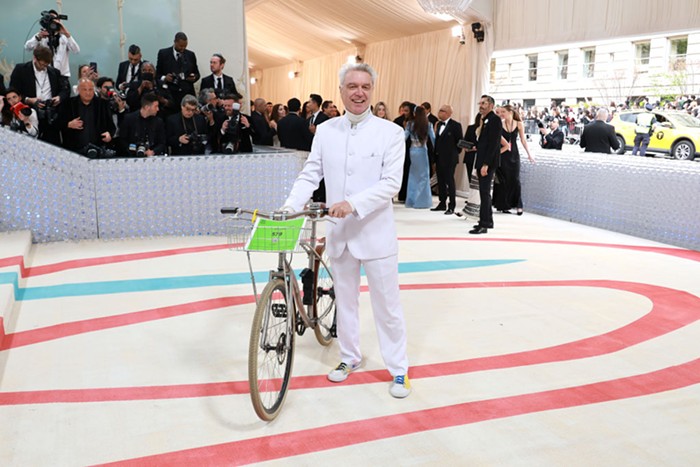
More than one month after the Seattle Times called her a "Macklemore sidekick" in a headline, local musician/poet/activist/City of Seattle Music Commissioner/all-around badass Hollis Wong-Wear is asking herself these questions:
"What good is an apology if it is not sincere? What good is an apology if it’s not followed up with a commitment to change? What can you really do with 'sorry, not sorry'?"
The original headline, written by an editor and slapped on a glowing profile of Wong-Wear and her The Flavr Blue band, was factually wrong and offensive—#NotYourAsianSidekick was a globally trending hashtag in 2013 because of the media's tendency to cast Asians, particularly Asian women, as sidekicks to white people.
After Wong-Wear protested, Times features editor Melissa Davis publicly apologized to Wong-Wear on Facebook and promised to follow up with her personally.
Davis called it a "teachable moment" for the city's media juggernaut and paper of record.
But how the Times actually followed up demonstrated how badly they had failed to learn anything from the "moment." As Wong-Wear explains in a must-read post on Medium, the still-unnamed male editor who wrote the original headline sent her a long, breathtakingly condescending e-mail:
He concluded the e-mail with an attempted mic drop: “My hope is that knowing this will help sideline your apparent outrage into something more positive.”
Just, wow: The sheer smugness of ending a purported apology message—for calling her "sidekick" in the first place—by telling Wong-Wear to "sideline" her "apparent outrage."
To make things worse, Davis, the features editor, then told Wong-Wear that the company wouldn't release detailed demographic data about its staff. Davis went on:
"People who are trying to make this about race or the race of our staff are focusing on the wrong issue.” Her e-mail was padded with how they had already apologized, what they had already learned.
Yesterday, in the wake of the Medium post, Times chief editor Kathy Best offered another apology to Wong-Wear and pledged to do better:
The discussion—both external and internal—provoked by that headline was painfully instructive on multiple levels. We are working on getting better internally at taking feedback and learning from it without getting defensive. We are growing from our mistake. We are creating spaces that didn’t previously exist for conversation about the diversity of our coverage and the diversity of our staff—racial, gender, age and more. We are trying to build understanding and communication within the staff and also trying to create connections today that will assure that our staff better reflects the communities we cover going forward...
Like you, I also want Seattle to win. And like you, I recognize that to be relevant in the city we love, we need our coverage to reflect the changing tide.
Wong-Wear declined to comment on Best's apology.
The Times could take action by pledging to be more transparent about its own diversity, or lack thereof. The paper currently shares its minority representation in the newsroom through an annual survey. But it doesn't share diversity data for all of its employees, doesn't break down the stats on a section-by-section or management tier basis, and the stats don't include gender.
According to the surveys, racial diversity at the Times has gotten worse, not better, over roughly the past decade. People of color made up 20.8 percent of the Times newsroom in 2015—a nearly two percent drop from 2004. Native Americans make up 0.6 percent of the Times newsroom; Asian-Americans, 9.5 percent; African-Americans, 3.6 percent; Hispanics, 7.1 percent.
The respective 2010 census figures for Seattle's population are Native Americans, 0.8 percent; Asian-Americans, 13.8 percent; African-Americans, 7.9 percent; Hispanics, 6.6 percent. 33 percent of the city's population are people of color.
Buzzfeed, for its part, annually discloses the gender and ethnic makeup of individual departments. Jose Antonio Vargas, who created the #JournalismSoWhite hashtag last month, singled out the organization for praise in a recent interview on the lack of diversity in newsrooms across the country. The Times could follow Buzzfeed's suit.
As for The Stranger: Our small news section—made up of three reporters and one editor, and not counting the other sections of the paper—has been exclusively white since I began interning here in 2013, with the lone exception of Danielle Henderson's few months here in 2014. And the section's editor has been exclusively white and male (and gay). Our section is also sometimes edited by Kathleen Richards, The Stranger’s managing editor and a woman of color.
And last week, our politics writer responded to internal and external complaints about the use of the word "catty" by agreeing to stop using the word to describe Hillary Clinton, while spending most of his words in that post attempting to rationalize why it wasn't serious problem to begin with.
I asked Tim Keck, our publisher, whether the paper will disclose its employee gender and racial makeup, as Buzzfeed does. "I think it's a good idea and we'll start publishing that info this year," he said. "I'll work with the staff on the best way to collect and share the data."
This post has been updated since its original publication.


















